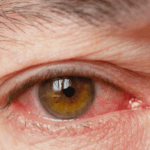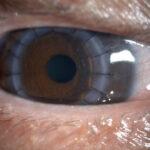Pterygium and pinguecula are conjunctival growths that form on the surface of the eye. Neither is dangerous and will not cause blindness. In the early stage, there is no effect on vision and the main concern is cosmetic appearance. So what’s the difference between them?
Pterygium is the fleshy triangular mass that extends to the cornea, while pinguecula is the yellowish elevated bump or lump that does not grow across the cornea. Pterygium can be a lot more obvious as it grows onto the clear surface of the cornea. It is also known to change the shape of the cornea, causing changes in vision which is an increase in astigmatism. Pterygium may grow over a period of months to years until it covers the cornea, only then will it interfere with vision. Pinguecula usually develops on the side of the eye and doesn’t typically grow to a larger size. Pinguecula does not typically harm your vision.

What causes these growths?
Both are caused by extended exposure to ultraviolet (UV) light (sunlight), wind and dust. They occur in people who spend more time outdoors, especially in hot, dry and sunny climates. The risk is also increased by not wearing sunglasses or a hat. People whose jobs expose them to UV light, such as fishermen, farmers and contractors, are also prone to develop this eye condition. Sailors, surfers and skiers are also more prone to develop pterygium as they encounter high levels of reflected UV light.
What do you feel?
Most people don’t feel anything. However, some people will experience foreign body sensation, grittiness and irritation in their eyes due to interference with the tear film. These symptoms are most difficult for contact lens wearers as the contact lens may not fit very well on the eye due to the uneven eye surface. Pinguecula and pterygium may occasionally get inflamed, and this will cause more discomfort, redness and grittiness. Furthermore, if the pterygium extends to the cornea, the curvature of the cornea will change and will cause some visual disturbances such as glare and blurred vision.
How are pterygium and pinguecula treated?
Once either one has formed on the eye, they will not go away by itself. An Ophthalmologist will do a full eye examination and determine the appropriate management for the pterygium and pinguecula. Lubricant eye drops can be prescribed to reduce irritation and discomfort and provide relief. Pterygium can remain small or will grow until extending towards the pupil.
It is important to have regular eye exams to monitor the progression of the pterygium. If eye drops do not help relieve symptoms and when a pterygium is large enough to interfere with vision, a pterygium removal surgery may be necessary to help restore vision. Unlike pterygium, pinguecula will not grow across your cornea, therefore surgery is not usually necessary. However, in some cases pinguecula can develop into a pterygium and affect vision.

How to prevent it?
Polarized sunglasses or hats with wide brim when outdoors can help to prevent and slow the progression of these types of tissue growth. People that work under exposure to sunlight can use appropriate protective eye equipment in work environments. Try to avoid exposure to environmental irritants such as smoke, dust, wind, and chemical pollutants. Protect your eyes from dust by wearing spectacles or goggles. It is also recommended to use artificial tears if you are exposed to dry conditions.






